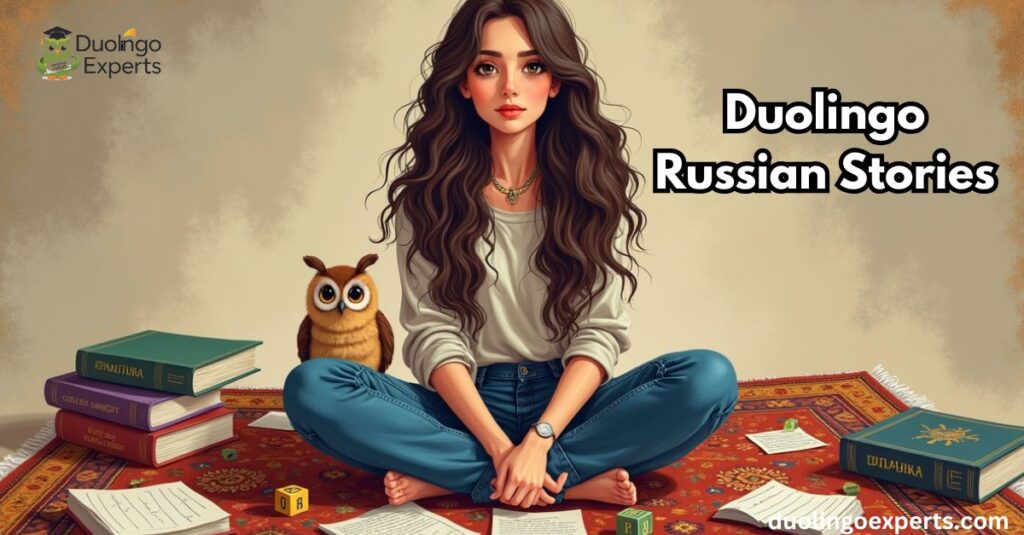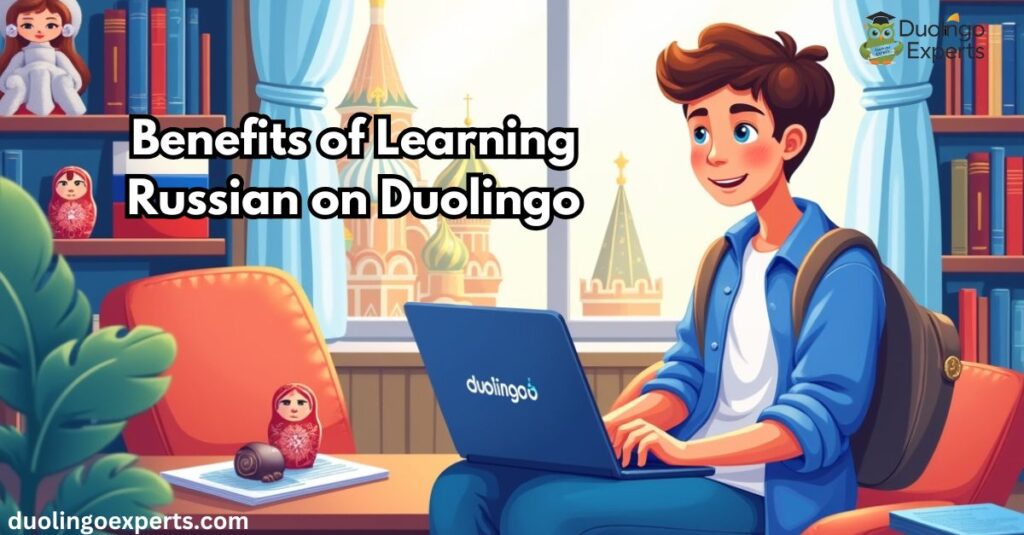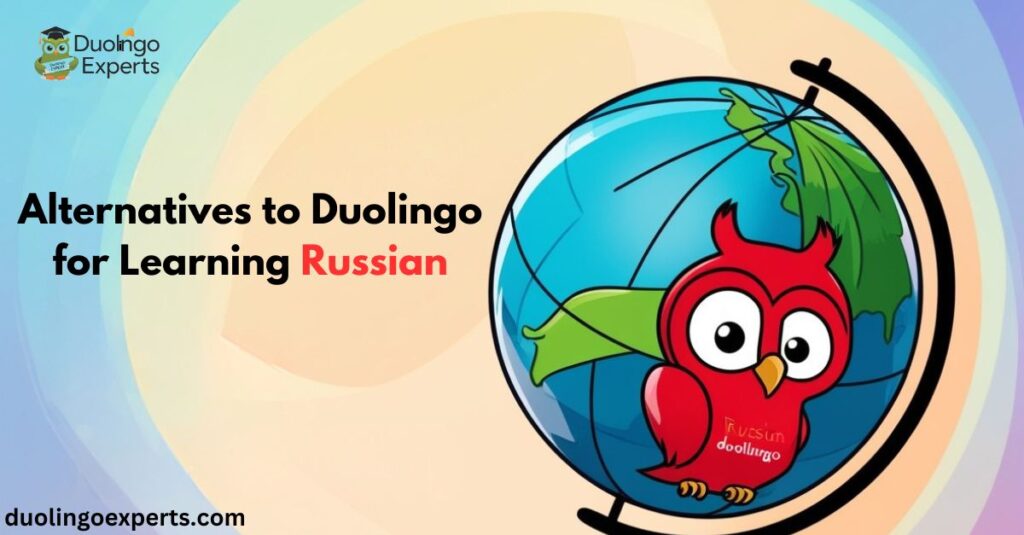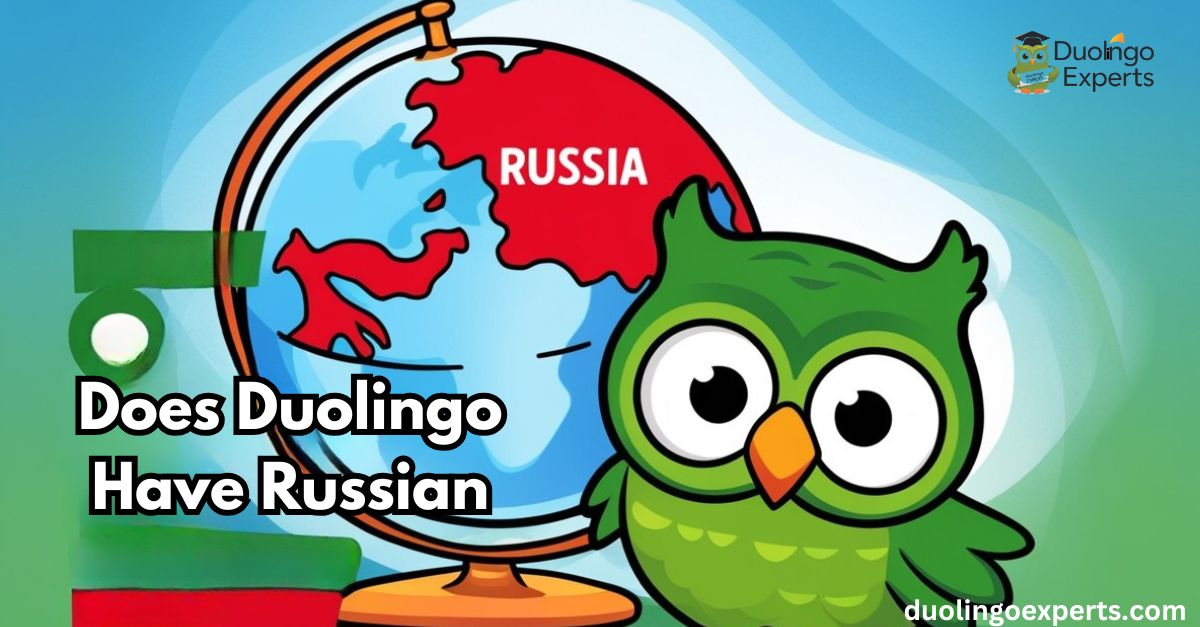Learning Russian has never been easier, thanks to platforms like Duolingo. Whether you’re a complete beginner, looking to refresh your skills, or diving deeper into the language, Duolingo offers a range of tools to help you on your journey.
But does Duolingo have a Russian course? And if so, how effective is it? In this comprehensive guide, we’ll explore everything you need to know about learning Russian on Duolingo, from course features to benefits, limitations, and how it compares with other apps.
Let’s explore into the details!
Does Duolingo Have Russian?
Yes, Duolingo does have a Russian course, and it has been available since 2013. When Duolingo initially launched its Russian course, it was aimed at helping English speakers learn Russian in a fun, interactive, and free environment.
Over the years, the course has evolved, and while it remains a valuable resource for beginners and intermediate learners, it’s important to understand exactly what it offers and what it doesn’t.
History of Duolingo Russian Course
Duolingo’s Russian course was one of the early additions after the platform started offering language lessons for free in 2011. Russian is the most widely spoken language in the Cyrillic alphabet, making it an important language for both cultural and professional reasons.
This is part of why Duolingo decided to offer Russian alongside other widely spoken languages, such as Spanish, French, and German. As of now, the Russian course on Duolingo is widely used by people around the world, offering a comprehensive set of lessons for learners of all levels.
The app’s approach has made Russian much more accessible, even for those who might otherwise be intimidated by the language’s unique alphabet, sounds, and grammar structure.
Why Choose Duolingo for Russian?
Duolingo’s popularity stems from several key features:
- Free Access: Duolingo is completely free to use, with an optional premium version (Duolingo Plus) for enhanced features.
- Gamification: The app’s use of XP points, streaks, and crowns helps motivate learners to stay engaged.
- Bite-Sized Lessons: Duolingo’s lessons are short, interactive, and built for quick, daily practice.
- Accessibility: You can learn Russian on Duolingo on your mobile device, tablet, or computer, making it easy to integrate language learning into your daily routine.
With all this in mind, Duolingo is an ideal starting point for those interested in learning Russian vocabulary and basic grammar.
Duolingo Russian Course Content & Features

Course Overview
The Duolingo Russian course is structured to guide learners through all the essential elements of the Russian language. Whether you’re learning Russian for travel, business, or cultural reasons, the course breaks down key concepts into manageable sections. This allows you to progress at your own pace, reviewing and practicing skills until they stick.
Here’s a breakdown of some of the main features:
- Russian Vocabulary: The course teaches essential vocabulary across different categories like food, family, numbers, and verbs.
- Cyrillic Alphabet: The course walks you through the Cyrillic alphabet, which is crucial for reading and writing Russian. You’ll start by learning the individual letters and then move on to how these letters combine to form words.
- Grammar Lessons: Duolingo covers important Russian grammar rules, including gendered nouns, verb conjugations, and sentence structure. The app’s interactive exercises help reinforce these concepts.
- Russian Pronunciation: Duolingo provides listening comprehension exercises to help you understand spoken Russian. It also uses speech recognition (powered by Automatic Speech Recognition (ASR)) to check your pronunciation of Russian words and phrases.
- Russian Stories: One of the standout features of Duolingo’s Russian course is its interactive stories. These are short, narrated dialogues that help you practice reading comprehension, listening skills, and conversational Russian in context.
How the Course is Structured
Duolingo’s Russian course is divided into skills, with each skill representing a specific topic or aspect of the language. You progress from one skill to the next, earning crowns as you master each unit. Below is an overview of the main sections and the skills they cover.
Basics 1 & 2
These introductory lessons cover essential Russian phrases like greetings, introductions, and simple sentences. You’ll also start learning the Cyrillic alphabet, one of the most crucial parts of learning Russian.
Food & Drink
In this section, you’ll learn how to order food, talk about drinks, and handle basic restaurant conversations. Vocabulary related to meals, drinks, and dining out will be introduced.
Travel & Directions
Here, Duolingo introduces you to essential vocabulary for getting around, such as transportation, directions, and places.
Pronouns, Verbs, and Nouns
This is where Duolingo dives into the structure of Russian. You’ll begin learning about gendered nouns, verb conjugations, and personal pronouns in Russian. This section is crucial because the case system in Russian can affect the form of words depending on their role in the sentence.
Russian Cases and Conjugations
Russian grammar relies heavily on its case system nominative, accusative, genitive, and others which impacts how nouns, adjectives, and pronouns change depending on their function in a sentence. This is a more advanced part of the course, and while Duolingo introduces these concepts, mastery requires practice.
Russian Stories and Listening Practice
As you progress, Duolingo introduces Russian Stories to help with comprehension. These short, engaging dialogues help reinforce new vocabulary and give you a better understanding of conversational Russian. These exercises also improve your listening skills and pronunciation.
Duolingo Russian Stories: A Deeper Look

Duolingo’s Russian Stories are a unique feature that can make learning the language more engaging and interactive. These stories are created to help learners practice listening comprehension, pronunciation, and cultural context.
Each story features:
- Realistic Conversations: These short stories simulate real-life scenarios, such as meeting someone for the first time, ordering food, or navigating the city. This helps learners pick up practical phrases and vocabulary.
- Interactive Format: Stories come with quizzes and questions that require you to select the correct answers, reinforcing language learning.
- Gradual Complexity: As you move forward in the course, the stories gradually become more complex, challenging you to learn more advanced vocabulary and grammar.
The stories also incorporate Named Entity Recognition (NER) and Tokenization, breaking down sentences into components like names, verbs, and places. This helps learners understand how different parts of the sentence fit together.
Learning Materials & Resources
Beyond the core lessons, Duolingo offers several supplementary resources to enhance the learning experience.
Duolingo Forum
The Duolingo Forum is a valuable resource for learners at all levels. It’s an active community where users can ask questions, exchange tips, and help each other solve common problems. If you’re struggling with a particular lesson or want advice on learning Russian grammar, the forum is a great place to seek help.
Duolingo Plus: The Premium Option
If you’re looking for an upgraded experience, Duolingo Plus offers several benefits:
- Ad-free experience: You can focus on learning without distractions.
- Offline access: Learn Russian even when you’re not connected to the internet.
- Unlimited hearts: Don’t worry about running out of hearts (which are used to track progress on lessons). With Duolingo Plus, you get unlimited retries on lessons.
Text-to-Speech (TTS) and Pronunciation Feedback
One of Duolingo’s standout features is Text-to-Speech (TTS), which converts Russian text into spoken language. This helps learners hear how words should sound and improves listening comprehension.
Additionally, Duolingo’s Automatic Speech Recognition (ASR) helps evaluate your pronunciation, ensuring you’re speaking Russian correctly.
Benefits of Learning Russian on Duolingo

Free and Accessible
Duolingo offers a free Russian course, making it accessible to everyone regardless of financial status. It’s available on mobile devices, tablets, and desktops, allowing you to learn at your own pace, wherever you are.
Gamified Learning
The app’s gamification aspect is a huge draw for learners. You earn XP points for completing lessons, which helps track your progress and keep you motivated. The streak feature also encourages daily practice, rewarding consistency and engagement.
Bite-Sized Lessons
Duolingo’s lessons are short, manageable, and easy to fit into any schedule. You can complete a lesson in just a few minutes, which makes it easier to maintain a regular learning routine.
Learn at Your Own Pace
Unlike traditional language courses, Duolingo allows you to progress at your own speed. You can take your time with each lesson or accelerate your learning if you feel ready for more challenges.
Personalized Feedback
Duolingo adapts to your learning style. If you’re struggling with a specific concept, the app will prompt you with additional practice in that area. It also offers semantic analysis to understand user input and optimize the learning path accordingly.
Limitations and Challenges of Duolingo Russian
While Duolingo is an excellent tool, it does have its drawbacks. Here are some challenges you may face while learning Russian on the platform:
Limited Advanced Grammar Lessons
While Duolingo introduces important Russian grammar rules, it doesn’t dive deeply into more complex concepts like verb aspect or detailed usage of Russian cases. For advanced learners, this might not be enough.
Lack of Real Conversations
Although Duolingo’s interactive exercises are useful, they don’t provide the real conversational practice that’s necessary to gain fluency. For speaking and conversational skills, you might need additional resources or language exchanges with native Russian speakers.
Limited Pronunciation Feedback
Duolingo’s speech recognition technology is helpful, but it’s not perfect. The system may sometimes overlook certain pronunciation errors or fail to give you the nuanced feedback that a live tutor could offer.
Missing Live Tutors or Group Classes
Unlike other platforms like Italki or Preply, Duolingo doesn’t offer live lessons or the ability to practice speaking with real Russian tutors. Some learners might miss this interactive element, especially as they progress beyond beginner levels.
Alternatives to Duolingo for Learning Russian

While Duolingo is great for beginners, other platforms might better suit your needs if you’re looking for a more comprehensive or specialized approach. Here are a few options:
- Babbel: Babbel offers more in-depth grammar lessons and real-world scenarios for learning Russian. It’s a paid service but provides structured lessons that progress logically from one to the next.
- Memrise: Memrise focuses heavily on vocabulary building through video clips of native speakers, making it an excellent choice for those looking to learn words and phrases quickly.
- LingoDeer: LingoDeer provides a deeper dive into Russian grammar and is particularly effective for beginners who want to understand sentence structure and syntax early on.
- Busuu: Busuu offers interactive lessons with native speakers, allowing you to practice conversation in real-time.
Frequently Asked Questions About Does Duolingo have Russian
Can you learn russian on Duolingo?
Yes, you can learn Russian on Duolingo, as it offers a comprehensive course that covers vocabulary, grammar, and pronunciation. It’s an excellent starting point for beginners looking to master the basics of the Russian language.
Is duolingo russian Good?
Yes, Duolingo’s Russian course is good for beginners, offering a gamified approach to learning essential vocabulary and grammar. However, it may not be sufficient for advanced learners seeking more in-depth understanding or conversational practice.
Can you actually learn Russian with Duolingo?
Yes, you can learn Russian with Duolingo, especially for building a strong foundation in vocabulary and basic grammar. However, for advanced fluency, you’ll need additional resources and real-life conversation practice.
Does Russia accept Duolingo?
Yes, Russia accepts Duolingo as a language learning tool, and many learners in Russia use it to study languages, including Russian and other foreign languages. However, Duolingo does not currently offer an official certification for proficiency in Russian recognized by the Russian government.
What level of Russian does Duolingo teach?
Duolingo teaches Russian primarily at the beginner to intermediate level, focusing on foundational vocabulary and basic grammar. While it’s great for starting your journey, advanced learners may need supplementary resources for fluency.
Is Duolingo available in Russia?
Yes, Duolingo is available in Russia and can be used to learn various languages, including Russian. The app is accessible via mobile devices and web browsers, making it widely available to learners in Russia.
Can I study in Russia without speaking Russian?
While it’s possible to study in Russia without speaking Russian, many universities offer courses in English. However, knowing the language can significantly enhance your experience and help you navigate daily life more easily.
Is a 100 Duolingo score accepted in the USA?
A 100 Duolingo score is accepted by many universities in the USA as proof of English proficiency. However, each institution has its own requirements, so it’s important to check the specific admissions criteria of your chosen school.
What is the hardest language to learn Russian?
Many consider Russian to be one of the hardest languages to learn due to its Cyrillic alphabet, complex grammar rules, and case system. However, with dedication and consistent practice, it’s definitely achievable for learners.
Is Babbel better than Duolingo?
Babbel offers more structured lessons and deeper grammar explanations, making it ideal for learners seeking a comprehensive approach. However, Duolingo is more gamified and free, making it a better option for casual learners or beginners.
Final Thoughts: Is Duolingo the Right Choice for Russian?
In conclusion, Duolingo is an excellent choice for beginners who want to learn Russian in a fun, engaging, and accessible way. The gamified learning approach, interactive exercises, and Russian stories make it a solid option for starting your language-learning journey.
However, while Duolingo is great for building foundational skills and Russian vocabulary, it may not be enough for advanced learners or those looking to perfect their grammar or fluency. To truly master Russian, you may need to combine Duolingo with other resources, such as live tutors, conversation practice, and more in-depth grammar studies.
Ultimately, Duolingo provides a fantastic Russian language learning app that can get you started on your way to fluency. Start today, practice regularly, and you’ll see improvement in no time!

DuolingoExperts, managed by MarkJohan, offers expert insights and tips for mastering languages. A tech-driven platform to enhance your learning experience.

